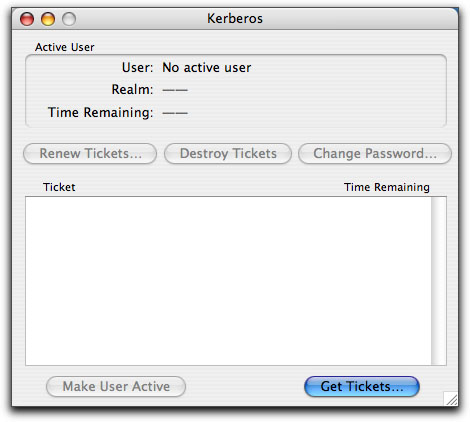

Overview Kerberos is a network authentication protocol designed to provide strong authentication for client/server applications. Stanford services that require Kerberos authentication include Stanford OpenAFS. Kerberos is already built-in to Mac OS X. Kerberos Commander configures Kerberos for use with the Stanford network.
I am running MacOs High Sierra 10.13 I need to remotely access a kerberised web UI (Hadoop Cluster / Ambari / Oozie Service UI to be specific) For that I first need to edit/configure the kerberos conf file to add the realm before calling kinit properly. I looked thoroughly, the Kerberos configuration file is not present in the system: Not a trace anywhere of a file called 'edu.mit.Kerberos' not 'krb5.conf'. But still, calling kinit outputs this: user@MBP:$ kinit kinit: krb5getdefaultprincipal: Configuration file does not specify default realm I am really curious where the configuration file is hidden if it ever exists. Anyway, I tried creating both /etc/krb.conf and /Library/Preferences/edu.mit.Kerberos with my realm configuration but I keep getting the same output. I am not even sure kerberos is installed by default properly on this version of MacOS, but I do have klist and kinit commands natively in usr/bin. I also tried to unload / reload the kerberos service but the corresonding plist files are also non existent sudo launchctl unload /System/Library/LaunchDaemons/edu.mit.Kerberos.kadmind.plist sudo launchctl unload /System/Library/LaunchDaemons/edu.mit.Kerberos.krb5kdc.plist sudo launchctl load /System/Library/LaunchDaemons/edu.mit.Kerberos.kadmind.plist sudo launchctl load /System/Library/LaunchDaemons/edu.mit.Kerberos.krb5kdc.plist all give No such file or directory I consulted the official MIT Documentation and but it didn't really help. The'y also advice to use 'Mac OS X Kerberos Extras' Utility, but I am a terminal guy, I really prefer to understand what I am doing and where the conf files are and what is really happening.

Kerberos For Apps For Sharepoint
Any help or decent documentation is welcome.
Authentication and Identification In Depth As explained in, authentication is the process by which a person, app, server, or other entity proves that it is who or what it says it is. Authentication is achieved through presenting something that you know, something that you have, some unique identifying feature, or some combination of these. To make authentication more convenient and efficient, many systems use some method of identification, which is a means of verifying that the person or entity is the same one you communicated with last time. In the physical world, this might be an ID card, a conference badge, or a colored wrist band. In computers, identification usually means issuing a ticket, token, or other credential at the end of the authentication process.
This chapter provides an in-depth explanation of types of authentication, tells you where to get information about writing new authentication schemes, and describes the authentication-related APIs and UI elements available to you in macOS. Common Types of Authentication. Note: Although this section may be of academic interest to developers, it is primarily geared toward system administrators, security researchers, and other nondeveloper audiences.
